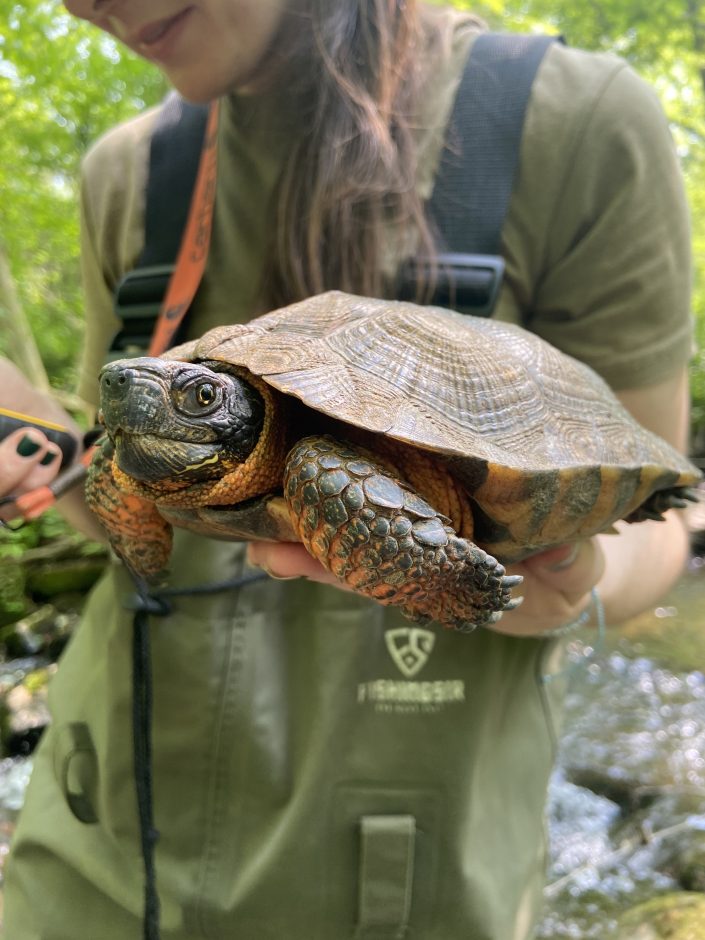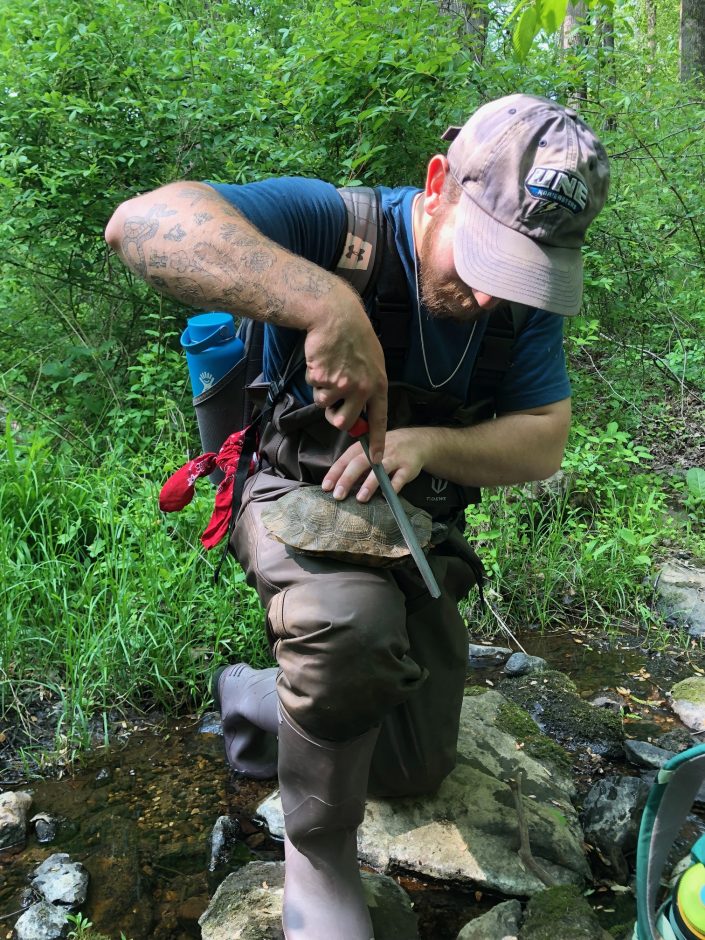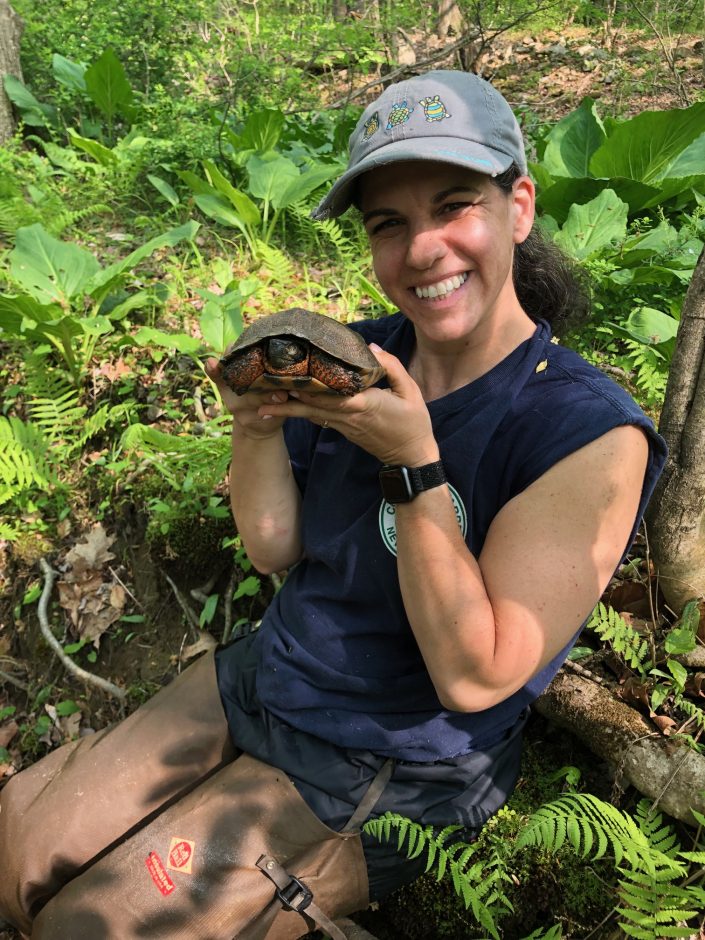Expanding CWF’s Turtle Portfolio
by Christine Healy, Wildlife Biologist
Etiquette tells us that we shouldn’t have a favorite child. I sometimes wonder if the same rules apply to biologists with regard to our study species. If so, my manners fall woefully short, at least where reptiles are concerned.
Conserve Wildlife Foundation has been partnering with the United States Fish and Wildlife Service (USFWS) on bog turtle conservation initiatives for years. We do this using a multi-faceted approach. We connect landowners with qualifying habitat with federal funding opportunities and technical support that can preserve and restore significant wetlands. We assist the state and nonprofit partners with visual surveys to better understand the status of historic populations. Finally, we suit up with USFWS personnel each fall and winter to remove invasive species and woody vegetation that are shading out nesting spots, rendering bogs and fens inhospitable to turtles. We applied to continue this work for the next few years but decided to shake things up a bit by adding in tasks targeting the protection of the bog turtle’s closest living relative… the wood turtle, a state threatened species that is currently under consideration for federal listing.

Photo Credit: Connor Zrinko
Don’t get me wrong – bog turtles are awesome. Finding one is especially thrilling since they are, as some might say, “New Jersey’s unicorns”. But ask any of my colleagues and they will surely tell you that wood turtles hold a special place in my heart. Studies have shown that wood turtles can navigate mazes as successfully as rats, demonstrating considerable intelligence for a reptile. In my non-scientific opinion, you can even see it in their eyes. Additionally, wood turtles inhabit streams and nearby forest/field environments which are generally a bit easier to navigate than the deep muck, characteristic of bog turtle habitat.

Through our new cooperative agreement, we seek to update the population records for stream corridors that have historically been significant for wood turtles in New Jersey. During our field surveys, we will be denoting impaired habitat or possible stressors like an absence of natural nesting sites, which could force females to cross roadways and risk motor vehicle collisions. Once we have this information, we will work with USFWS to enhance the habitat and encourage neighboring landowners to consider the needs of turtles in forest management plans/mowing regimes. We began our work on this project in March and are coming to the end of our first survey year.
We conduct our population assessments using a methodology recommended by the Northeast Wood Turtle Working Group; a collaborative of 28 experts from Virginia to New Brunswick, Canada, that established protocols for researchers throughout the region to follow to standardize mapping, data collection, and reporting. Surveys are performed along stream segments that measure 1 km in length, with three repetitions in the spring prior to nesting and three in the fall before turtles enter brumation. During each survey, researchers record information on terrestrial and aquatic characteristics (like stream depth, temperature, weather conditions, etc.) that might impact the quality of the habitat and/or influence the ability to detect wood turtles. On cooler days, the search effort may be focused on the stream itself, while warmer conditions may draw turtles out of the water to bask on the surrounding banks. To reduce biases related to survey length, we endeavor to stick to a 1 km/hour pace.
When turtles are located along a transect, we carefully capture them using a net or our hands and stop the clock. One of the best ways to tell the sex of a turtle is to take a look at the plastron, or the bottom of their shell. Females tend to have a flattened plastron while males have a concavity to them, which assists with mating. After determining sex, we then inspect the carapace, or the top of the shell. The “scales” on a turtle’s shell are called scutes. Wood turtles (and all the other species that we work with) typically have 5 scutes that run along their spine (vertebral scutes), 4 on either side along their ribs (costal scutes), and 12 on each outside edge (marginal scutes). We can tell if a turtle has been previously identified by looking for small triangular markings along the marginal scutes. Each marginal scute represents a number, so adding the scute markings together will allow us to identify an individual’s unique code. The state keeps a database of found turtles, so recapture data allows them to track turtle survival and growth. Notching (when performed by a trained scientist) does not hurt turtles and enables us to establish more accurate population estimates.

Like trees, turtle scutes grow in “rings” called annuli. Counting the annuli can give a researcher a rough indication of an individual’s age but can wear down quickly. Generally, only 10 or 11 annuli are visible before the shells become too worn to count. We evaluate each turtle’s health and behavior and then take measurements before we release them back into their habitat.
We’ve had a great first year on the project, with 19 turtles found to date. Of those, 9 were new to the state record and the sex ratio was close to 50:50. Perhaps the most exciting result, however, was the sighting of a juvenile. Turtles can be a challenge when it comes to conservation due to their long lifespans. A population may appear healthy from a number’s standpoint, but if all the individuals are of the same age class that false sense of security can lead managers to overlook a lack of recruitment of younger turtles into the breeding population. Once older individuals begin to die off, the population then suddenly plumets, leading to localized extirpation or extinction. This underscores the importance of beginning conservation work on long-lived species before it is recognized as critically necessary.
We will continue our survey efforts in 2024 and begin planning our outreach and enhancement work. We’ve already got our sights set on a section of severely eroded streambank where we found one turtle actively burrowing. Stay tuned for possible restoration details!
Shout out to Jen Correa-Kruegel, Park Naturalist for the Warren County Land Preservation Department for her contributions to our survey effort!

Discover more from Conserve Wildlife Foundation of NJ
Subscribe to get the latest posts sent to your email.